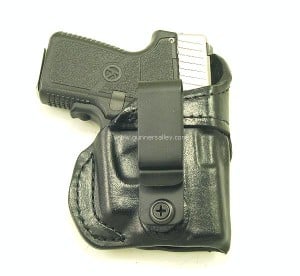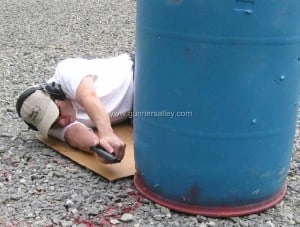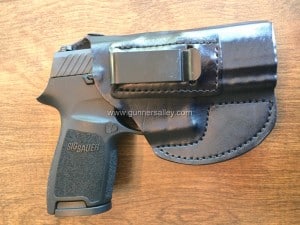Recently, we’ve had a few customers in the shop pose the question “How many rounds should you run through a new pistol to be confident enough to carry it?“
It’s a good question so I thought I’d share some thoughts on it here. Now keep in mind, these are just opinions based on my own beliefs and experiences so your own mileage may vary.
The process I follow varies depending on if the pistol is a carry gun or just a range gun. A carry gun follows the process outlined below, but I’m more tolerant on a range only gun.
Before we get into answering the how many rounds question, we have to first address the break-in rounds, which is a hotly debated topic. My humble opinion on break-in rounds: Whether it’s part of the official manual for any pistol or not, all new handguns will need a break-in period, and that period will vary model to model. Depending on what brand you happen to be a fan of, you may or may not agree with that statement, as some contend that certain brands are “battle ready” out of the box. They may very well be according to the manufacture’s literature, but I personally won’t carry a pistol for CCW until I’ve had the chance to break it in and ensure that it performs as it should.
So why bother with the break-in process if the pistol was successfully test fired at the factory? For me, the break-in process does 3 things:
- Actually ensures that the weapon operates properly since things can and do happen from the time it was test fired to the time it arrives in my possession.
- Gives me an opportunity to familiarize myself with the controls and operation.
- Serves as the first stage of my own personal process to determine if a weapon is ready to carry.
Just to share some experiences on how varied and different the break-in process can be based on the gun maker and model, here are details on the break-in process I experienced on 3 different gun models:
 Kahr P380
Kahr P380
I had some prior experience with the Kahr line but none with a brand new Kahr. My prior experiences with Kahr were good so I expected the P380 to be no different. The P380 manual from Kahr suggested shooting the pistol at least 200 rounds to break-in it. During the first few shots, we (myself and and few other guys here at Gunner’s Alley) were less than impressed with the cycling, feeding, and general reliability. The trigger felt rougher than previous Kahr models I had shot, and by about round 20, I was starting to have some doubts about the purchase as I’d already had multiple FTE’s with decent ammo. However, I decided to keep shooting until we hit the suggested 200 rounds. At round 200 or so, things still really weren’t any better and I was seriously thinking about sending it back to Kahr. At round 205 or 206, a crazy thing happened. It was like a switch was flipped on the gun and literally everything changed. The trigger smoothed up like butter and the action began running very smooth. And the change wasn’t gradual, it was literally from one shot to the next. Since the break-in period, the P380 has ran like a top with no issues whatsoever, eating whatever ammo it’s fed. Honestly, if I hadn’t gone the full 200 rounds break-in, I would have sent it back and been making a huge mistake, as it’s my go to pocket gun these days.
Glock 30
If you read the various Glock manuals, I haven’t seen where they advocate a specific break-in round count. A few years ago, I took my new in the box G30 to the range and started shooting. No hiccups, no issues (even with lower end ammo), nothing. The process was actually kind of boring. With no issues after 100 rounds, I felt the G30 was more than broken in. Honestly, it was probably ready at 20 rounds, but I like to be sure. However, I would like to point out that even Glocks can and do occasionally have issues so I still perform a break-in process on every Glock I carry.
Les Baer Custom Carry 5″ 9mm
Man this thing was so tight, you could barely rack the slide without using 2 hands. The unofficial break-in recommendation from Les Baer is 500 rounds or so. While we haven’t have had the chance to run a full 500 rounds through this gun yet, we do have around 200 through it. Currently, this gun exhibits an occasional failure to extract (FTE) but we haven’t been able to determine if that’s an ammo issue (seems to occur across different types of ammo) or just the fact that the gun isn’t completely broken in. Until that issue either resolves itself or is resolved through a trip back to Les Baer, I personally wouldn’t consider that gun being ready for CCW. However, my past experiences with a variety of Les Baer guns are similar to my experience with the Kahr – just after the break in, everything starts working like it should.
The take-away on these examples is the fact that each gun, no matter who makes it, will have a break-in period. The question really becomes is the break-in period 5 shots or 500 shots? The owners manual will usually provide some guidance. Some are super specific, such as the Kimber Solo, which has a break-in period of 24 rounds (at least the model we had was 24 rounds), while other brands won’t/don’t provide any guidance on break-in at all. In cases where the owner’s manual doesn’t offer specific information on a break-in round count, I shoot until I’m comfortable.
 Now back to the original question of how many rounds do you shoot until a carry gun is ready to be carried? Above and beyond the break-in period, my personal number (sounds like a Sleep number bed commercial!) is 100. Once a weapon is broken-in, I like to see a gun run at least 100 rounds of my chosen self defense ammo without a hiccup or issue. If I can’t get 100 rounds through it without a problem, it just isn’t ready to be carried IMHO. Now that’s just my own personal number, and I know shooters who use a lower number and others who use a higher number. Like anything else in life, if you asked the question to 10 different people, you’ll hear 10 different answers. It’s really a personal decision as what your own comfort level will be. We’d love to hear your comments below and learn what your own personal number is?
Now back to the original question of how many rounds do you shoot until a carry gun is ready to be carried? Above and beyond the break-in period, my personal number (sounds like a Sleep number bed commercial!) is 100. Once a weapon is broken-in, I like to see a gun run at least 100 rounds of my chosen self defense ammo without a hiccup or issue. If I can’t get 100 rounds through it without a problem, it just isn’t ready to be carried IMHO. Now that’s just my own personal number, and I know shooters who use a lower number and others who use a higher number. Like anything else in life, if you asked the question to 10 different people, you’ll hear 10 different answers. It’s really a personal decision as what your own comfort level will be. We’d love to hear your comments below and learn what your own personal number is?


